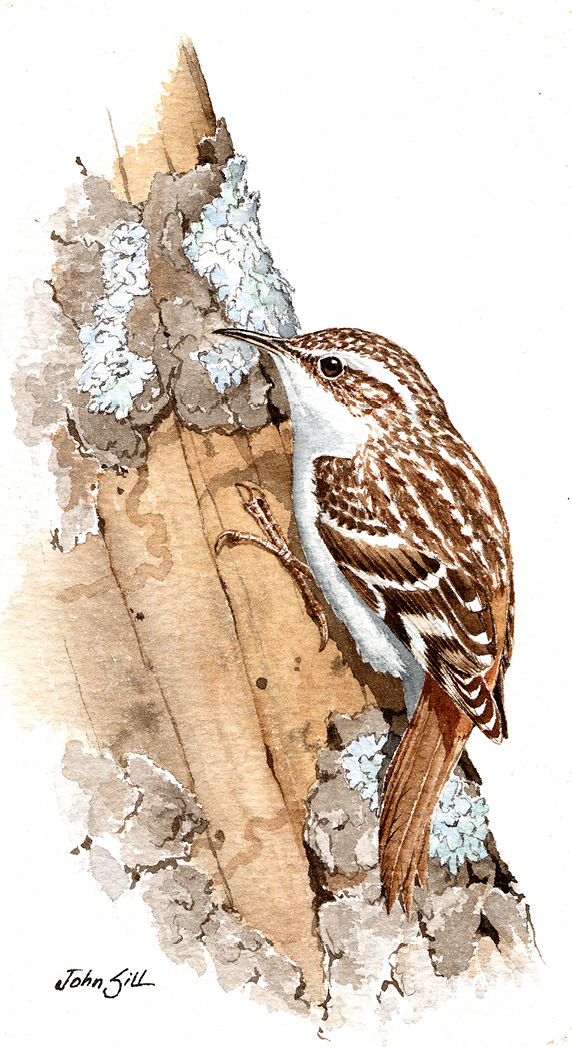Brown Creeper by John Sill

Brown Creeper by John Sill © Massachusetts Audubon Society. Courtesy of the Museum of American Bird Art.
John Sill is a freelance wildlife artist living in the mountains of North Carolina. He was the illustrator for the Bird Identification Calendar for Mass Audubon for many years. His work has appeared in Birds In Art at the Leigh-Yawkey Woodson Art Museum, Wausau, Wisconsin, and in Art of the Animal Kingdom at the Bennington Center for the Arts in Vermont. He continues to illustrate the "About" and "About Habitats" series of natural history books for children written by his wife Cathryn.
Brown Creeper
The only treecreeper in North America, the Brown Creeper (Certhia americana) is a cryptic species. Its tree-creeping behavior is distinctive, but when it is stationary on a tree it is virtually invisible because its coloration blends perfectly with its surroundings. Its high-pitched call also makes it difficult to locate. As a result, much of its biology, including its migratory behavior, is poorly known. The Brown Creeper is mottled dark brown and white above and white below. It has fine white streaking on its brown crown and sports a prominent white supercilium. The bill is thin and decurved, and the long, stiff tail serves as a prop. The sexes are similar in plumage and juveniles resemble adults but are duller in appearance. A whopping 13 subspecies are currently recognized with C. a. americana occurring in our area. The Brown Creeper is closely related to the Old World Eurasian Treecreeper (C. familiaris), with which it was long considered conspecific.
Brown Creeper breeding range in the West is complex, extending in coastal and some interior areas from Alaska south through California and from southwest Canada south through the Rockies to southern Mexico, with outliers through Central America to Nicaragua. Their range extends from western Canada to Newfoundland, excluding the prairie regions. In the eastern United States, they range from the Great Lakes region to the Northeast and south to Virginia. Brown Creepers are resident through most of their range but in most of southern Canada through Newfoundland the population is migratory, wintering throughout most of the United States to northern Florida and northeastern Mexico. In Massachusetts, the Brown Creeper is considered an uncommon resident and uncommon to common migrant. Spring migrants pass through in late April and early May; fall migration occurs mostly in September.
Brown Creepers are probably monogamous and produce a single brood. Both song and calls consist of high-pitched tee notes. The song, given throughout the breeding season by males only, consists of a series of four to nine hissing notes. Little is known of courtship behavior, but chases are common, and wing-fluttering and courtship feeding of the female are known. Pair formation may occur in February or March, before the territory is established.
Brown Creepers breed in coniferous and coniferous-deciduous mature to old-growth forest, preferring closed-canopy forests with dead trees; their winter habitat is more variable. The nest site, located under a loose flap of bark or sometimes a cavity in a dead or dying tree, is chosen by both parents. They occasionally nest in odd places of human origin such as under loose roof shingles or behind a window shutter. The female constructs the nest and provides most of the nest material. The nest, which is connected to the loose bark, consists of a crescent-shaped base of bark and twigs, interlaced with spider web. The cup is attached to the base and is made of fine bark, hair, feathers, and lichen. The female, who develops a brood patch, incubates the clutch of five to six white eggs, spotted with dark colors, for about two weeks until hatching. The male feeds the incubating female. The chicks are altricial, nearly naked and with their eyes closed. Only the female broods for the 15–17 days until fledging. The fledged young stay as a group with the parents or may split into two groups with each group following one adult. The young birds roost together away from their parents. Both parents feed the young for several weeks after fledging, but for how long after that is unknown.
Brown Creepers specialize in foraging for bark-dwelling invertebrates. They have long curved claws, long toes, short legs, and long stiff tails, all adaptations for hopping upwards and around tree trunks. Typically they start foraging at the bottom of a tree and spiral up it to the top, after which they fly to the base of a neighboring tree and repeat the process. They sometimes forage on branches as well. They mostly glean and probe the furrows in the bark with their long, decurved bills. They occasionally hawk flying insects and hover-glean. They take a wide variety of insects and larvae, spiders, pseudoscorpions (an arachnid group), and ants. They occasionally take seeds. In winter Brown Creepers may visit suet feeders and frequently join mixed-species foraging flocks.
Brown Creepers are subject to nest predation by squirrels and other mammalian predators; hawks and owls take adults. The presence of an avian predator is greeted by a freeze response; their cryptic plumage often saves them. In New England, numbers have increased over the decades, probably due to reforestation and the death of mature trees, such as elms from Dutch Elm disease, and damage from gypsy moth infestations. In the West, populations have declined due to deforestation. For example, they have decreased in the Pacific Northwest with the harvesting of old-growth Douglas fir forests. Population trends are difficult to assess, however, because of the cryptic nature of the species. The dependence of Brown Creepers on mature and old-growth forests is worrying because these forests experience heavy pressure from logging and other human interventions. We hope that our only treecreeper will continue to brighten our days in the future.
William E. Davis, Jr.